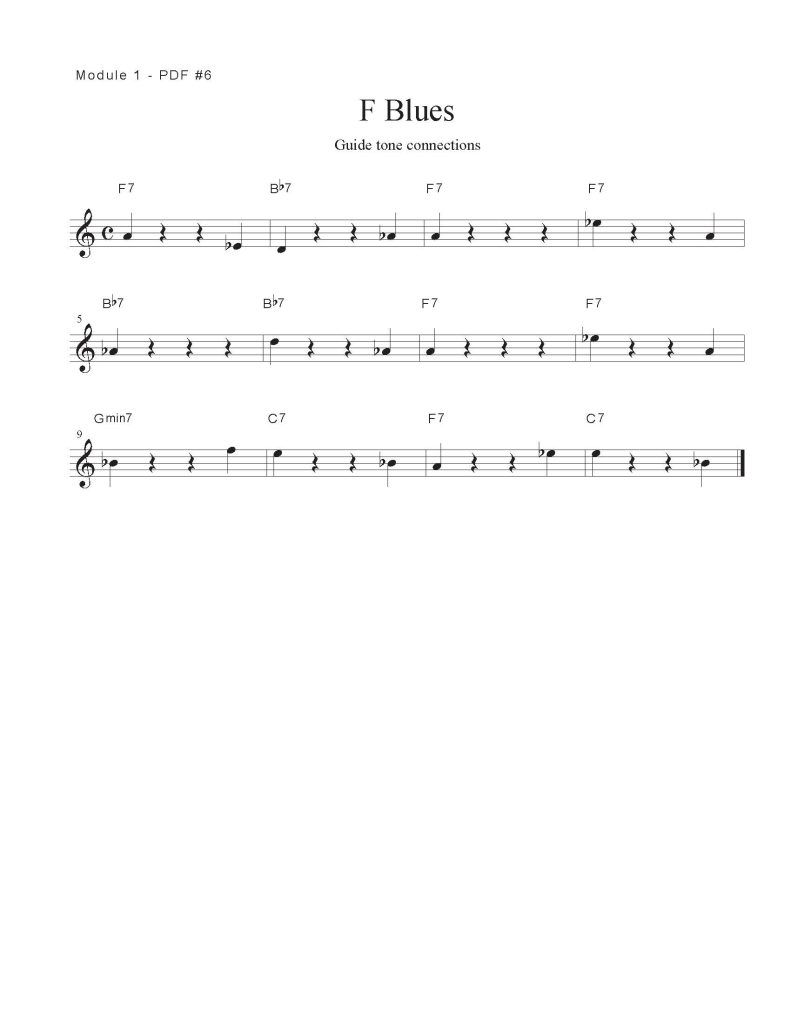The blues is an enduring formal structure in jazz and other Black American musical styles. The blues continues as a foundational form and harmonic sequence in jazz playing and learning. There is a century-plus of recorded and written blues material that informs the playing – on some level – of all jazz musicians. To begin with this form is not intended to imply that this form is easy but the beauty of its simplicity is part of its lasting impact and beauty.
Each module contains:
- A set of concepts and approaches
- Suggested ways to practice and apply new ideas
- Creative ways to broaden the application of concepts
- Goals and projects to demonstrate developing vocabulary and concepts

Download or Print Module 2 – PDF #2 Blues Chord Progression in F Concert
The blues can be played in any of the 12 keys, but the most common keys used in jazz are Concert F, Bb and C. These examples will focus on blues in the key of F. It’s important to note that these chords are the among the most basic forms of the blues. Jazz musicians have added chords over the years to make the blues more complex and challenging (e.g. “Blues for Alice” by Charlie Parker). The steps below are used to get familiar with the chords before diving right into trying to improvise. Following these steps will help to hear the chords and their movement, as well as getting comfortable with the pace of the twelve-measure form.
*Refer to the following Spotify Playlist – The Blues for many examples.
Remember, listening is just as important as practicing.
Try playing through the chords according to the steps below by yourself (a cappella) with a metronome. Once you are comfortable playing through the form in time, then try it with the blues in one F Blues Play-A-Longs.
Refer to the playing examples of every variation below.
Bass Only
Drums Only
Bass and Drums
Piano and Drums
Full Rhythm
- Play triads: 1,3,5 in time through the progression
- Walk a bass line with triads connecting the root by 1/2 step below
- Walk a bass line with triads connecting the root by 1/2 step above
- Walk a bass line with triads connecting the root by 1/2 step below or above
- Play triads in other inversions: 5,1,3 etc… (try a few combinations)
- Improvise with triads only
- Improvise with triads and connect by half step to 1,3 or 5
- Play 7th chords: 1,3,5,7
- Play 7th chord inversions: Your choice – there are 24 combinations
- Guide tones: Map out the 3rd’s and 7’s (these chord tones are the most important to hearing the quality of the chords and connecting improvised lines). Refer to Module 1 – PDF #6
- Incorporate the scales into improvisation. Remember, the chord tones are still your best note choices. Try filling in the chord tones with some of the scale notes. For example: Instead of playing F, A, C for the F chord, play F, G, A, Bb, C (putting scale tones in between 1, 3, and 5
Just because there are 7 notes in a major/minor scale doesn’t mean you need to play them all.

